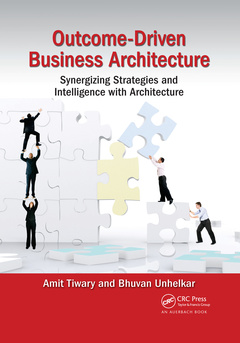Outcome-Driven Business Architecture Synergizing Strategies and Intelligence with Architecture
Auteurs : Tiwary Amit, Unhelkar Bhuvan

This book discusses business architecture as a basis for aligning efforts with outcomes. It views BA as complementary to enterprise architecture, where the focus of technological initiatives and inventories is to understand and improve business organization, business direction, and business decision-making. This book provides a practical, long-term view on BA. Based on the authors' consulting experience and industrial research, the material in this book is a valuable addition to the thought processes around BA and EA. The lead author has direct and practical experience with large clients in applying APQC capability framework for undertaking multiple enterprise-wide capability assessments.
List of Figures
List of Tables
Acknowledgments
Foreword
Preface
Authors
Section A CONCEPTS AND ODBA FRAMEWORK
1 Business Strategies and Outcome-Driven Business Architecture
2 Developing Business Architecture I—Capabilities and Challenges
3 Developing Business Architecture—II
4 Building and Assessing Business Capabilities—I
5 Implementing Business Capabilities—II
6 Metrics and Measurements with Outcome-Driven Business Architecture
7 Governance, Risk, and Compliance and Quality
Section B PRACTICE AND TOOLS
8 Establishing and Managing the Business Architecture Practice
9 ODBA, Big Data, and a Functioning Agile Organization
Section C CASE STUDIES
10 Business Architecture and Capability Case Study 1—Manufacturing Industry
11 ODBA and Capability-Building Case Study 2—Energy Market
12 Business Architecture and Capability Case Study 3—Government Services
Bibliography
Index
Bhuvan Unhelkar (BE, MDBA, MSc, PhD, FACS) has spent close to three decades in the information and communication technologies (ICT) industry as a strategist as well as a hands-on professional. As the founder of MethodScience.com, he has demonstrated consulting and training expertise in business analysis, software engineering, Agile processes, mobile business, and Green IT (environment) in banking, financial, insurance, government, and telecom verticals. He is an adjunct associate professor with the University of Western Sydney, Australia (where he had formed the Mobile Internet Research and Applications Group—MIRAG) and a visiting faculty at the University of Technology, Sydney, MS University, Baroda, India, and Rensselaer Polytechnic Institute (Hartford Graduate Campus), CT, USA. He has authored 17 books and several executive reports (Cutter, Boston, USA), supervised numerous PhD students, and has extensively presented and published papers and case studies. Dr. Unhelkar is a Fellow of the Australian Computer Society, life member of Computer Society of India, president of the Rotary Club in St. Ives, Sydney (and a Paul Harris Fellow), a Discovery volunteer at NSW parks and wildlife, and a previous TiE mentor. Dr. Unhelkar obtained the PhD degree in the area of "object orientation" from the University of Technology, Sydney, in 1997. Subsequently, he has designed and delivered course units such as Global Information Systems, Object Oriented Analysis and Design, Business Process Reengineering, and IT Project Management to the industry as well as across universities in Australia, China, and India.
Amit Tiwary has over three decades' experience in developing pragmatic, implementable enterprise architecture (EA) solutions for customer base ranging from manufacturing, utilities, government, and financial sector. Amit recently implemented an EA and BA framework for a large organization which has proven to be an extremely valuable communication device and has been
Date de parution : 09-2020
17.8x25.4 cm
Date de parution : 08-2018
17.8x25.4 cm
Thèmes d’Outcome-Driven Business Architecture :
Mots-clés :
Outcome Driven Business Architecture; Business Capabilities; Enterprise architecture; Big Data Adoption; Business architecture; Enterprise Project Management Office; Collaborative Intelligence; Single Customer View; Enterprise architecture planning; Business Process; business intelligence; Vice Versa; Bhuvan Unhelkar; GRC; Tiwary Amit; Business Capabilities Required; Unhelkar Bhuvan; Develop Business Capabilities; BA; APQC; CRM System; BA Practice; Heat Map; Reactive Reporting; Manage Strategic Initiative; Big Data; Common Language; Achievable Business Outcomes; Capability Gaps; Agile Business; ICT Capability; Competency Center; Agile Organization



